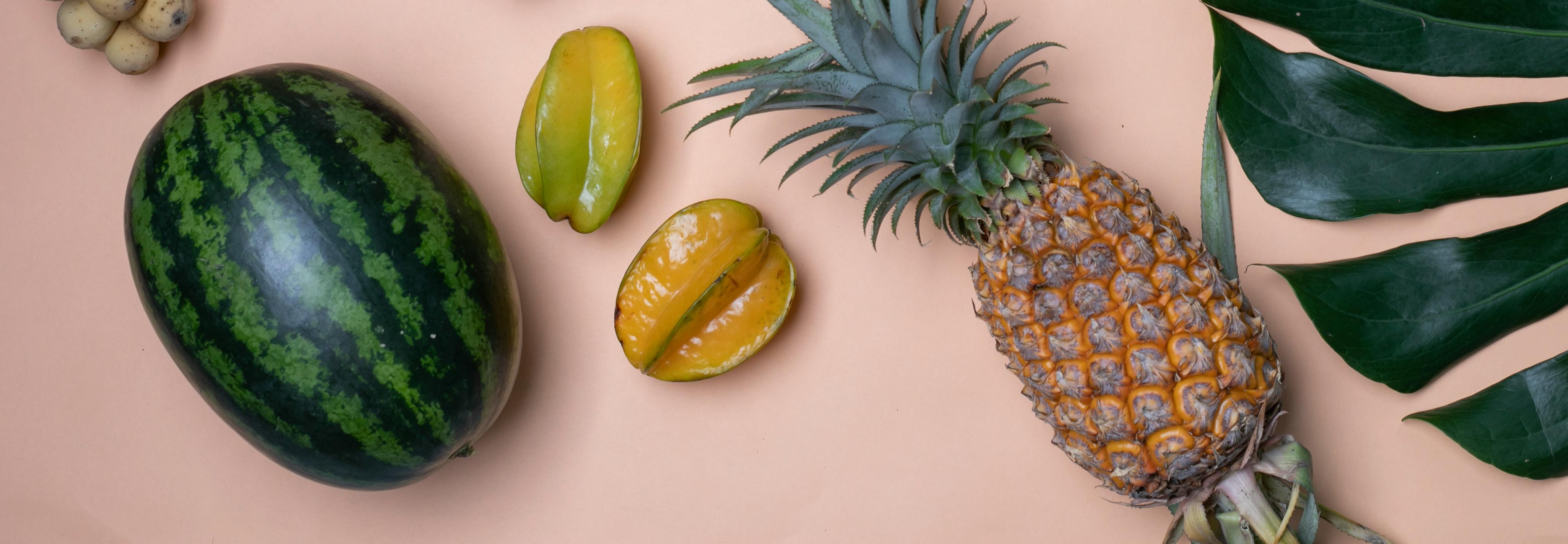Star fruit, also known as carambola, is a unique and delicious tropical fruit that is native to Southeast Asia. It has a star-like shape and a sweet-tart flavor. While it can be eaten raw or used in recipes, knowing when the star fruit is ripe is important for getting the best flavor. This article will explain how to tell if star fruit is ripe so you can enjoy it at its peak of flavor and texture.To check the ripeness of a star fruit, look for a yellow-orange color on the skin. Gently press the skin with your thumb; it should give slightly. Avoid star fruits that have soft spots or dark patches on the skin. Smell the star fruit; it should have a sweet aroma. Finally, pick up the star fruit and feel its weight; it should be heavy for its size. If all these criteria are met, then you have a ripe star fruit!
Signs That a Star Fruit is Ripe
Star fruit, also known as carambola, is a tropical fruit with sweet and tart flavors. It has a unique star shape when cut crosswise. When choosing a ripe star fruit, it is important to look for certain signs that indicate it is ready to be harvested. Here are some signs that a star fruit is ripe and ready to be eaten:
1. Color – Ripe star fruit have an even yellow color with hints of green or orange on the edges. Unripe fruit will be bright green in color with no yellow hues.
2. Texture – The skin of ripe star fruit will be slightly waxy and feel soft when gently squeezed. Unripe star fruits will feel firm and slightly hard when pressed.
3. Aroma – Ripe star fruits have a sweet aroma that is very distinct from unripe ones which have no scent at all.
4. Taste – The taste of ripe star fruits should be sweet and slightly tart, while unripe ones are usually sour and almost bitter in taste.
These are just some of the signs that can help you identify if a star fruit is ripe or not ready for harvesting yet. If you find one that meets all these criteria, then it’s time to enjoy this delicious tropical treat!
Color as an Indicator of Ripeness in Star Fruit
Star fruit, also known as carambola, is a tropical fruit native to Southeast Asia and is now grown in many parts of the world. The star-shaped fruit is known for its sweet-tart flavor and its unique shape. When it comes to picking out a ripe star fruit, many people look for color as an indicator of ripeness.
The most common type of star fruit has smooth, yellow skin when ripe. The yellow color is the result of chlorophyll breaking down when the fruit has ripened on the tree. Some star fruits may have a slight green tinge to them even when they are ripe, so it’s important to look for other signs of ripeness too.
Ripe star fruits should feel firm but slightly soft when lightly pressed with your fingers. They should have a sweet smell and their five ridges should be slightly raised. If you cut open a ripe star fruit, the flesh should be juicy and yellow with no brown discoloration or seeds visible. If these signs are present then you can be sure that your star fruit is ripe and ready to eat or use in recipes.
It’s important to note that not all star fruits will turn yellow when ripe; there are also varieties that remain green even when fully ripe. With green-skinned varieties, look for other signs such as those mentioned above to check if the fruit is ready to eat.
In summary, color can be used as an indicator of ripeness in some types of star fruits but not all varieties will turn yellow when they have reached maturity on the tree. Therefore it’s important to check for other signs such as firmness, smell and raised ridges before consuming the sweet-tart tropical treat.
Checking for Firmness in Star Fruit
When selecting a star fruit, the firmness is an important factor to consider. The ideal star fruit should be slightly firm, but not too hard. If the fruit is too hard, it may indicate that it is under-ripe and too soft, it may be over-ripe. To check for firmness, lightly press the surface of the star fruit with your finger. It should have some give but be firm enough that it does not dent or leave an imprint on the skin. Additionally, you can also smell the stem end of the fruit to make sure it has a sweet aroma; if it has a sour smell or no smell at all, it might mean that the star fruit is not ripe enough yet.
When selecting star fruit, you should also look for ones that are free from bruises and blemishes on their skin; these can indicate that the inside of the fruit is damaged and no longer fresh. Finally, check for signs of mold or decay; these should be avoided as they will likely affect the taste and texture of the star fruit.
Smell as a Sign of Ripeness in Star Fruit
The smell of star fruit can be an indication of its ripeness. When the fruit is ripe, it will have a subtle sweet aroma that’s similar to honeydew melon. If the star fruit does not smell sweet, then it’s most likely not ripe yet and should be left to ripen further. The smell can also indicate whether or not the star fruit is overripe. If the smell is overly pungent, then the fruit is most likely past its prime and should be thrown away.
When trying to determine whether a star fruit is ripe, color can also be an indication. A ripe star fruit will have a yellow-green color with some areas slightly turning yellow. If there are no yellow spots on the skin, then the star fruit may not be ripe yet and should be left to sit for a few days before being consumed.
In addition to smelling and looking for color changes, texture can also help in determining if a starfruit is ripe or not. A ripe starfruit should feel slightly soft when gently pressed with your fingers but still remain firm overall. If it feels too soft or mushy when pressed, then it may be overripe and should be discarded.
Overall, using smell, color and texture are all great ways to determine if your starfruit is ripe or not before consuming it. If you’re unsure about any of these indicators, it’s best to err on the side of caution and throw away any questionable fruits rather than risk eating something unripe or overripe that could make you sick.

Cutting Open a Star Fruit to Check Ripeness
Star fruits, also known as carambolas, are tropical fruits that can be enjoyed when they are ripe. To check the ripeness of a star fruit, it is important to cut it open and inspect it. To do this, start by washing the fruit with water and then drying it with a paper towel. Then use a sharp knife to cut off both ends of the star fruit. Next, make two lengthwise cuts so that the star fruit is quartered. Finally, use your hands to pull apart the four quarters to inspect them for ripeness. The flesh should be yellow or golden in color and have a sweet smell. If it is not ripe, the flesh should have an unpleasant odor or be greenish-yellow in color. The seeds inside should also be soft enough to easily chew and swallow. Once you have checked the ripeness of the star fruit, you can enjoy eating it as is or add it to salads and other dishes for added flavor and nutrition.
The Benefits of Eating Ripe Star Fruit
Star fruit, also known as carambola, is a tropical fruit with a sweet and sour taste. It is native to Southeast Asia but is now grown in many countries around the world. Star fruit is an excellent source of dietary fiber, vitamin C, and several other essential nutrients. Eating ripe star fruit has many health benefits, including improved digestion, better heart health, and increased energy levels.
Star fruit contains dietary fiber which helps to promote regularity in the digestive system. The fiber in star fruit helps to prevent constipation and keep the digestive system running smoothly. In addition to this, fiber can also help reduce cholesterol levels, which can lower the risk of heart disease.
Vitamin C is essential for maintaining a healthy immune system and fighting off infections and illnesses. Star fruit contains high amounts of vitamin C which helps to strengthen the immune system and fight off colds or other illnesses more quickly. Vitamin C can also help protect against cell damage caused by free radicals.
Eating star fruit can also provide an energy boost due to its high levels of natural sugars such as glucose and fructose. The sugars found in star fruit are quickly absorbed into the bloodstream providing a quick burst of energy to help you stay alert and focused throughout the day. The natural sugars found in starfruit are also beneficial for athletes as they provide fuel for longer workouts or longer periods of physical activity.
Overall, eating ripe starfruit provides numerous health benefits due to its high amounts of dietary fiber, vitamin C, and natural sugars. Starfruit can be enjoyed raw or juiced for maximum nutrition benefits. Adding starfruit to your daily diet can help improve digestion, boost your immune system, and provide a quick burst of energy throughout your day!
Is Eating Unripe Star Fruit Safe?
Eating unripe star fruit can be dangerous as it contains high levels of oxalic acid. This acid can cause kidney failure in certain individuals, particularly those with pre-existing kidney conditions. It is therefore important to be aware of the risks before consuming star fruit, especially when it is unripe.
The danger of unripe star fruits lies in the fact that they contain a much higher concentration of oxalic acid than ripe fruits. The presence of oxalic acid can lead to an accumulation of toxins in the body, which can damage the kidneys and cause them to shut down. This is especially true for people with pre-existing kidney conditions or those who are taking certain medications such as antacids or diuretics.
In addition to oxalic acid, unripe star fruit also has a bitter taste and astringent texture, making it unpleasant to consume. Therefore, it is best to only consume ripe star fruit that has been properly ripened and has a sweet taste. If you are uncertain about the ripeness of your star fruit, you should consult a nutritionist or other healthcare professional who can advise you on how to safely enjoy this delicious fruit.
In general, unripe star fruit should be avoided due to its potential health risks. However, if you do decide to consume it, make sure that you do so in moderation and discuss any potential risks with your doctor beforehand.

Conclusion
Knowing how to tell if a star fruit is ripe is important in order to enjoy the full flavor and texture of this unique fruit. Its appearance can be deceiving, but by paying attention to the color, shape, and feel of the fruit, you can determine whether or not it’s ready to eat. If it’s yellow with a slight bit of green around the edges and feels firm but slightly soft when pressed, then it’s ripe. Avoid star fruits that are overly soft and have brown spots as they will be overripe.
With these tips on how to tell if star fruit is ripe, you can now select the best fruits for your enjoyment. Enjoy this sweet and tart tropical treat in salads, desserts, smoothies or just on its own!


